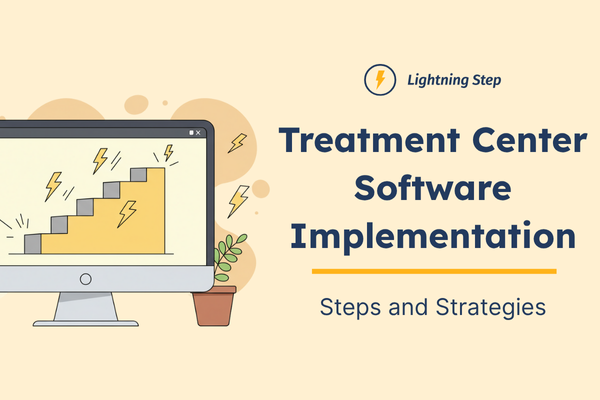
Did you know only 34% of community mental health agencies have fully integrated EHR systems [source]? Yet according to the 2025 Addiction Treatment Center Industry Statistics & Facts, treatment centers are under pressure to adopt technology that improves patient outcomes, streamlines operations, and ensures compliance. Treatment centers face mounting pressure to deliver exceptional patient care while managing complex administrative tasks and maintaining strict compliance standards. The right treatment center software implementation can transform operations, but success depends on strategic planning and execution.
Your software selection determines everything that follows. Start with core requirements: electronic health records (EHR) capabilities, appointment scheduling, billing and payment processing, telehealth functionality, reporting and analytics, and mobile access.
When evaluating telehealth, look for HIPAA-compliant video conferencing, EHR interoperability, a patient portal, secure messaging, and AI-powered automation [source].
Map these features against your clinical workflows and organizational goals. Does your team need robust documentation tools? How important is real-time patient data access? Will you require integration with existing systems?
Ensure HIPAA compliance and specialized modules for 42 CFR Part 2 substance-use records are built into your chosen platform.
Lightning Step's all-in-one platform addresses these needs by combining CRM, EMR, and RCM capabilities in a single system. The single-login system eliminates duplicate work, and LIA, our AI assistant, automates documentation tasks—saving clinicians over 12.5 hours per month. The platform offers configurable forms that adapt to your specific treatment protocols, an intuitive user interface that reduces training time, and built-in compliance modules that streamline regulatory requirements.
Consider scalability during evaluation. Your chosen solution should grow with your organization without requiring complete system overhauls.
Successful implementation starts with thorough preparation. Map your existing processes to identify gaps and inefficiencies. Document current workflows, from patient intake to discharge, noting pain points and bottlenecks.
Form a cross-functional project team including clinical staff, administrators, IT personnel, and billing specialists. Use a RACI matrix to clarify roles and responsibilities across stakeholders, improving accountability and communication [source]. Secure leadership buy-in early - executive support drives adoption throughout the organization.
Develop a comprehensive data migration strategy. Clean existing data before transfer, establish data validation protocols, and create backup procedures. Lightning Step's EMR system includes data import tools and dedicated implementation support to streamline this process.
Create realistic timelines with built-in buffer periods. A phased or incremental approach is the best practice for EHR implementations, allowing for gradual adoption, thorough testing, and comprehensive user training.
Staff training makes or breaks implementation success. Develop role-based training plans that focus on specific job functions. Clinicians need different skills than billing staff or administrators.
Conduct hands-on workshops using real patient scenarios. Practice sessions build confidence and reveal potential workflow issues before go-live. Identify super-users within each department who can provide ongoing peer support.
Plan for continuous learning. Schedule refresher sessions, maintain updated knowledge bases, and create easy-to-access help resources. Lightning Step provides user-friendly dashboards that reduce the learning curve and offers 24/7 support resources to assist staff during adoption.
Address change resistance proactively. Communicate benefits clearly, involve skeptical staff in planning processes, and celebrate early wins to build momentum.
Resistance to change often stems from fear of the unknown. Combat this through transparent communication about implementation goals and benefits. Run pilot programs with willing participants to demonstrate value before full rollout.
Integration challenges with existing systems require careful planning. Map data flows between systems, test interfaces thoroughly, and maintain fallback procedures during transition periods.
Conduct a force field analysis to identify driving and restraining forces in adoption [source].
Ensure data security compliance throughout implementation. Treatment centers face unique challenges due to sensitive behavioral health information requiring additional safeguards under regulations like 42 CFR Part 2.
Consider modular pricing options that allow gradual feature adoption as your organization grows comfortable with new processes.
Lightning Step's CRM capabilities include configurable workflows and automated task assignments that reduce manual administrative work. The system routes referrals automatically, schedules follow-up appointments, and tracks patient progress through treatment stages.
Real-time dashboards provide instant visibility into key metrics, while custom reporting tools help meet CARF, HIPAA, and Joint Commission requirements. Built-in audit trails document all system activities for compliance reviews. Reporting aligns with CARF outcomes-measurement requirements and Joint Commission trauma-informed care standards.
The platform's telehealth integration and secure messaging features support remote care delivery without compromising security. Revenue cycle management tools streamline billing processes and improve cash flow through automated insurance verification and claims processing.
Track key performance indicators to measure implementation success. Monitor system utilization rates, billing cycle times, patient engagement metrics, and clinical outcomes. Focus on revenue-cycle KPIs in 2025 to optimize financial performance. Essential KPIs for treatment centers include tracking treatment completion rates, patient retention rates, and operational efficiency metrics.
For example, centers using robust analytics saw a 20% reduction in billing cycle time within six months [source].
Use Lightning Step's analytics and reporting capabilities to monitor progress against established goals. The platform provides real-time insights into operational efficiency and supports evidence-based program evaluation.
Establish feedback loops with staff and patients. Regular surveys and focus groups identify areas for improvement and guide system optimization efforts. Schedule quarterly reviews to assess performance and adjust workflows as needed.
Document lessons learned and best practices for future reference. This knowledge base becomes invaluable for onboarding new staff and planning system upgrades.
By following these best practices and leveraging Lightning Step's unified CRM, EMR, and RCM platform—with real-time data, AI-powered documentation, and built-in compliance—you'll reduce administrative burden and elevate patient care. Schedule your personalized demo to see how Lightning Step can transform your treatment workflows.



